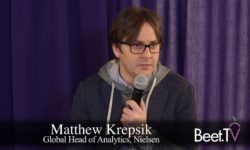Marketers that are seeking to better understand consumers’ identities need to start by earning consumer trust and then build platforms that are “privacy by design” were two main takeaways from a panel at the recent Beet.TV leadership forum.
It seems likely there won’t be one central identity graph for each person judging from comments by Matthew Krepsik, Nielsen’s Global Head of Analytics, Carol Hinnant, EVP of National Television Sales at Comscore and Bob Ivins, Chief Data Officer at NCC Media at the forum titled Identity in Focus: Understanding the Cross-Screen Consumer in a Fragmented World. The panel was moderated by Matt Prohaska, CEO & Principle of Prohaska Consulting.
“If you don’t have consumer trust, it does not matter what technology solutions we put in place, the device graphs, the different partnerships, or any sort of math or data science we put behind it,” said Krepsik.
He cited regulations like GDPR in the European Union and the nascent California privacy act known as CPPA as being guiding forces. “I think just throwing technology and math at a problem without actually winning the trust of consumers sets our industry back,” Krepsik added.
Hinnant agreed with Krepsik and underscored the need to move beyond rating points to audiences in media transactions. “We have to help that conversion for all the ecosystem to go through and it’s the identity graph that helps that or the panels that help do that,” said Hinnant.
Prohaska mentioned the sharing of user phone numbers by Facebook without consent as one extreme, while observing that many people have been satisfied with a value proposition that involves the use of their data. “We’re in a bifurcated world,” he said.
“You have some people that will go one way and maybe a vast majority to the other,” said Hinnant. “But if we can help communicate what the value is to the consumer and educate them on what it means to be able to protect their privacy, I think that would be helpful.”
Ivins related the frustration of having to provide his credit card number while buying an airplane ticket online from a company with which he had done business before. “What do you mean you don’t store my credit card? I’ve been doing this for so long. It’s one of these things that you want to know who has what.”
With regard to Facebook and other digital advertising giants, Ivins said “there’s a message being sent there” by a backlash characterized by a decline in user engagement. “Whether they listen to it or not is TBD.”
From NCC’s perspective, “One of the issues that we’re looking at is I don’t want to be single threaded through one ID graph. I think that’s dangerous,” said Ivins about relying on one company. “I think we need to have some flexibility in that situation.”
Krepsik talked about people regardless of age or gender having to watch commercials for erectile disfunction products.
“What’s the biggest differentiation between me and my daughter? I’m a male, she’s a female. My son, he’s ten now. He doesn’t really even need to see an erectile dysfunctional ad at the age of ten. So you need his age.”
There needs to be a foundation that provides “a view of real people to underpin that measurement to build trust,” Krepsik said. “You can’t just live with one identity graph. We have different sources of information around people, around persons. And so it does have to be persons-based, but more importantly it has to be distributed. There’s not going to be a magical decoder ring where all the data’s going to sit in one spot.”
This video was produced in New York City at Identity in Focus: Understanding the Cross-Screen Consumer in a Fragmented World, a Beet.TV Leadership Forum, presented by 4INFO and hosted by Viacom. For more videos from the series, please visit this page.











![How [M]Platform Helps GroupM Identify Audiences: Tanwir Danish](https://www.beet.tv/wp-content/uploads/2019/03/groupm-tanwir-danish-thumbnail-250x150.jpg)



























